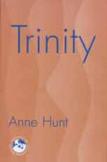The Key Link
Anne Hunt, an Australian Catholic theologian and author of several previous books on the doctrine of the Trinity, aims in this book “to explore and present the trinitarian nexus or interconnection of the mystery of the Trinity with the other great mysteries of the Christian faith.” Thus “Theology as ‘faith seeking understanding’ here finds expression as ‘faith seeking connections.’” In the first chapter, Hunt summarizes the historical development of the doctrine of the Trinity, both in Scripture and in patristic and medieval times. Attention is given to Augustine and Aquinas, but likewise to Richard of St. Victor, Bonaventure and two medieval mystics (Jan Van Ruusbroec and Julian of Norwich). Chapter 2 provides an overview of contemporary Trinitarian theology as presented by Karl Rahner, Leonardo Boff, Elizabeth Johnson, John Zizioulas, Bernard Lonergan, Hans Urs von Balthasar and Jürgen Moltmann. Here the author notes how the social model for the doctrine of the Trinity, Trinity as the communion of divine persons, seems to have gained ascendancy over the classical psychological model originally put forth by Augustine and Aquinas.
Turning then to the interconnection between the doctrine of the Trinity and the other mysteries of the Christian faith, Hunt explores first the link with Christology. After surveying the decrees of the early councils of the church, she analyzes the Trinitarian Christology of Christoph Schwobel and Jacques Dupuis. These theologians put a new emphasis on relationality as the key to a contemporary understanding of both doctrines. The following chapter deals with a theme explored in an earlier book, namely, the Trinity and the paschal mystery, and analyzes and compares the reflections of Sebastian Moore and François-Xavier Durrwell. In the next chapter, “Trinity and Creation, Ecology and Evolution,” Hunt again provides a historical introduction to the doctrine of creation before studying the work of Wolfhart Pannenberg and Denis Edwards. The same approach is followed in the chapter on Trinity and church: a historical survey of church teaching, followed by exposition of the writings of Leonardo Boff, Miroslav Volf, John Zizioulas, John-Marie-Roger Tillard and Joseph Cardinal Ratzinger.
In Chapter 7, “Trinity and the World Religions,” the author explores the historical roots of the maxim “no salvation outside the church” before examining the thought of Karl Rahner, Raimon Panikkar and Jacques Dupuis on this controversial topic. Hunt favors the approach of Dupuis, because it seems better to allow for religious pluralism (e.g., the work of the divine Word and the divine Spirit in the world, even apart from institutional Christianity) without sacrificing belief in the uniqueness of Jesus Christ. The eighth chapter, on the Trinity, grace and the moral life, features the writings of Karl Rahner, Anthony Kelly and Catherine Mowry LaCugna. The ninth then takes up the theme of Trinity, spirituality and worship—including analysis of the Trinitarian spirituality of Michael Downey and Ghislain Lafont, along with Hunt’s own understanding of the Trinitarian rhythm of the eucharistic liturgy. Chapter 10, which considers Trinity and eschatology, focuses on the work of Wolfhart Pannenberg, with special attention to the activity of the Holy Spirit in the consummation of creation. A final chapter summarizes the major points of the book, enabling the reader to see more clearly the interconnection of the doctrine of the Trinity with all the other mysteries of the Christian faith.
In evaluating this book, one should first take note of its careful scholarship. The survey of authors on the Trinity is impressive, and the endnotes provide valuable additional information. There is an index and a useful glossary of technical terms as well. Yet as the concluding chapter confirms, Hunt does not present a single consistent understanding of the doctrine of the Trinity and the God-world relationship. Instead, she offers a survey of the views of others, together with personal comments on the value of these positions. In her earlier books, Hunt justified this somewhat eclectic approach in line with Bernard Lonergan’s appeal to the stages of meaning in his book Method in Theology (Herder & Herder, 1972).
In effect, the author’s goal is personal appropriation of the differing insights of others on a given issue, not their objective reconciliation in an overarching system. This methodology certainly works well in the humanities, where hermeneutics, the interpretation of texts, is the operative methodology. But is it equally viable in a religion-science context, where a single unified system of causal explanation is standard procedure?
I likewise found it curious that Hunt makes only passing (and always negative) reference to process theology in this book, even though there is a considerable body of secondary literature on the use of Alfred North Whitehead’s process-relational metaphysics as a governing conceptuality for the God-world relationship (including various attempts at a Trinitarian conception of God from a process perspective). Whitehead’s philosophy is generally recognized as the most consistent effort to date to present a postmodern metaphysics based on principles of relationality and interconnectedness (such as the social model of the Trinity endorses). Hence, it could possibly provide the uniform system of explanation for the doctrine of the Trinity that is lacking in Hunt’s otherwise carefully researched treatise.
This article also appeared in print, under the headline “The Key Link,” in the November 7, 2005, issue.








